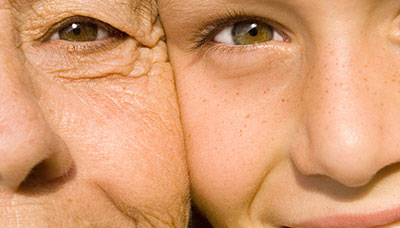Key points
- Going to the eye doctor is part of taking care of your overall health.
- Eye exams at every age and life stage can help keep your vision strong.

About eye exams
Many people think their eyesight is just fine without realizing they may need glasses or contact lenses. But about 11 million Americans over age 12 need vision correction. But that's just one reason to get your eyes examined. Regular eye exams are also an important part of finding eye diseases early to protect your vision.
Eye diseases are common and can go unnoticed for a long time. Some eye problems don't have any symptoms in their early stages. A comprehensive dilated eye exam by an eye doctor can find eye diseases in the early stages. This is when treatment to prevent vision loss is most effective.
During the exam, your eyes and vision will be tested. Your eye doctor can see behind your eyes and check for signs of health problems as well. They may even be able to spot other conditions such as high blood pressure or diabetes.
Common eye problems
Early treatment is critically important to prevent vision loss or blindness from some common eye problems:
Cataracts, which cause clouding of the lens, are the leading cause of vision loss in the United States.
Diabetic retinopathy causes damage to blood vessels in the back of the eye. It's the leading cause of blindness in American adults. Diabetic retinopathy is one of the most preventable causes of vision loss and blindness. Early detection and treatment can prevent or delay blindness from diabetic retinopathy in 90% of people with diabetes. Diabetes can also increase the risk of other eye problems like cataracts or glaucoma.
Glaucoma is a group of diseases that damages the optic nerve.
Age-related macular degeneration causes gradual breakdown of light-sensitive tissue in the eye.
Only half of people at high risk for vision loss visit an eye doctor every year. Regular eye care can have a life-changing impact on preserving the vision of millions of people.
Start early
Though people tend to have more vision problems as they get older, children need eye exams too. But only less than half of preschool children have had their vision tested to check for common eye diseases.

Amblyopia, or lazy eye, causes reduced vision because the eye and brain aren't working together properly. It's the most common cause of vision loss in children, causing vision loss in 2 to 3 out of 100 children. Amblyopia needs to be treated promptly to help avoid vision loss.
How often to get eye exams
Children's eyes should be checked regularly by an eye doctor or pediatrician. The US Preventive Services Task Force recommends that children have at least one eye exam between age 3 and 5 years. This can detect amblyopia or risk factors for it.
People with diabetes should have a dilated eye exam every year.
Some people are at higher risk for glaucoma and should have a dilated eye exam every 2 years:
- Black Americans 40 years and older.
- All adults older than 60, especially Mexican American adults.
- People with a family history of glaucoma.
Other reasons to see an eye doctor
If you have any of the following eye problems, don't wait for your next appointment. Visit your eye doctor as soon as possible:
- Decreased vision.
- Draining or redness of the eye.
- Eye pain.
- Double vision.
- Floaters (tiny specks that appear to float before your eyes).
- Circles (halos) around lights.
- Flashes of light.
What you can do
The number of people with vision loss and blindness may continue to increase in the coming years. Take care of your vision health as part of your overall health and wellness. Encourage family and friends to do the same. Now is the time to prevent vision loss and blindness, and improve your quality of life.
